ITALY BLASTS JAPAN FOR FOOT-DRAGGING
Rome, Italy · October 8, 1941
Two months before Great Britain joined the United States in declaring war on Japan, Italian dictator Benito Mussolini chose to use this date in 1941 to blast the Japanese for not carrying their weight in the Tripartite Pact, a political, economic, and military agreement that Italy, Germany, and Japan had signed the year before. Italy had declared war on Great Britain and France on June 10, 1940, but Japan had not joined its treaty partners in declaring war on any of Germany’s and Italy’s enemies. Mussolini assured Tokyo that the U.S. would not come to Britain’s aid in the event of war between Japan and Britain. If Japan failed to join the conflict now, the Duce said, no matter which side won, the loss to be sustained by Japan “will be great.” The Japanese waited two more months before unleashing a Blitzkrieg-style offensive against British and American interests in the Asia Pacific region. The first steps they took against the British occurred on December 8 when they bombed Singapore, the hugely important British base on the tip of the Malay Peninsula, and sent ground forces from Thailand (occupied December 9) into the British colony of Burma (present-day Myanmar) to threaten the British defense of India. Between December 10 and 13, Japanese forces moving south from their initial landings in Thailand secured major airfields in the north of Malaya. On December 16, 1941, the Japanese captured Victoria Point (today’s Kawthaung), a vital British airfield halfway up the Malay Peninsula; in so doing they cut off aerial resupply of local British forces. From Victoria Point, Japanese fighter aircraft were able to escort bombers on raids into southern Burma, particularly against the Burmese capital, Rangoon (Yangon), 500 miles to the northwest. The Malayan capital, Kuala Lumpur, fell to the Japanese on January 12, 1942, followed by Singapore a little over a month later and Burma’s capital on March 8. By occupying French Indochina and the states to the west, the Japanese were in a preeminent position in Southeast Asia. In mid-January 1942, Mussolini withdrew his criticism of Japan when the three Axis powers renewed their Tripartite Pact in Berlin. The pact divided the globe into areas of operation, and gave Japan complete freedom of action in all areas from the Western Pacific to the western border of India (see map).
[amazon_carousel widget_type=”ASINList” width=”600″ height=”200″ title=”Recommended Reading” market_place=”US” shuffle_products=”False” show_border=”False” asin=”0842051538,1842122606,9971692732,9971692996,067402219X,1782002685,0755100395,0300103735,0773536302,1862271291″ /]
Axis Division of the World into Spheres of Operation and Influence
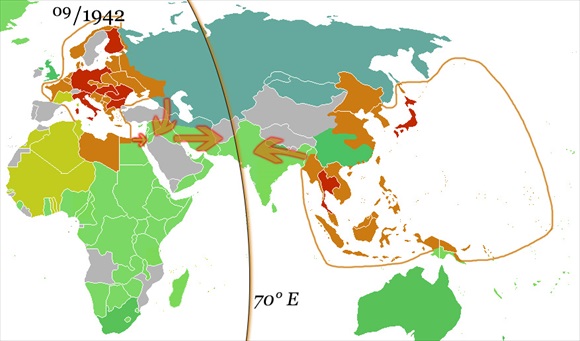 |
Above: German/Italian and Japanese spheres of global reach. Arrows show planned movements of the three Axis powers, their occupied territories, and spheres of influence (red and tan) to the agreed demarcation line at 70°E, which was the western frontier of British India.
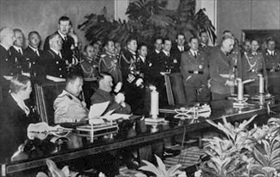 | 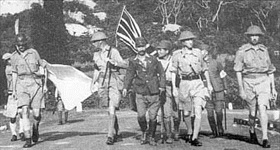 |
Left: On September 27, 1940, the Axis Powers (Nazi Germany and Fascist Italy) grew by one when Japanese ambassador Saburō Kurusu (left in photo), Italian foreign minister Count Galeazzo Ciano (to Kurusu’s left), and German foreign minister Joachim von Ribbentrop (standing at podium at right) signed the Tripartite Pact. Adolf Hitler (slumping in his chair) witnessed the gala proceedings. The treaty recognized the right of Germany and Italy to establish a “new order” in Europe and Japan to impose a “new order” in Asia (see map above).
![]()
Right: Lt. Gen. Arthur Percival, led by a Japanese officer, walks under a flag of truce to negotiate the capitulation of Commonwealth forces in Singapore, February 15, 1942. The siege and the ignominious surrender of Singapore, Britain’s “Gibraltar of the Orient,” to a much smaller Japanese force (36,000) was the greatest defeat in British military history. Over 80,000 British, Australian, and Indian troops fell into Japanese hands. Imprisonment, torture, illness, and many, many deaths awaited the captured ones.
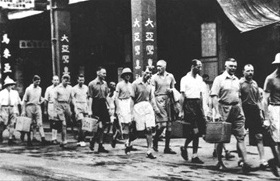 | 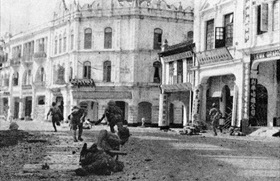 |
Left: The Japanese occupation of Hong Kong began on December 25, 1941 (locally known as “Black Christmas”), after two-and-one-half weeks of fierce fighting against overwhelming Japanese forces that had invaded the British Crown colony. Hong Kong’s surrender initiated almost four years of brutal Japanese administration. Some 7,000 British, Canadian, and Indian soldiers and civilians were kept in prisoner-of-war or internment camps, where famine, malnourishment, and sickness were pervasive. In this photo Japanese soldiers escort British, American, and Dutch bankers to detention in a small Chinese hotel; some bankers were executed as enemies of Japan. The Japanese government sold the Hong Kong dollar to help finance their wartime economy.
![]()
Right: Japanese troops advance through the streets of Malaya’s capital, Kuala Lumpur. The Malayan Campaign lasted from December 8, 1941, to January 31, 1942. For the British, Indian, Australian, and Malayan forces defending the colony, the campaign was a total disaster: 40,000 men were captured, 5,500 killed, and 5,000 wounded. On the last day of January the last organized Allied forces left Malaya for Singapore, which the Japanese invaded on February 7, 1942. The Japanese completed their conquest of the island on February 15, capturing 80,000 more prisoners out of 85,000 Allied defenders.
Japanese Campaigns in Burma and Northeast India, 1941–1945
![]()

 History buffs, there is good news! The Daily Chronicles of World War II is now available as an ebook for $4.99 on Amazon.com. Containing a year’s worth of dated entries from this website, the ebook brings the story of this tumultuous era to life in a compelling, authoritative, and succinct manner. Featuring inventive navigation aids, the ebook enables readers to instantly move forward or backward by month and date to different dated entries. Simple and elegant! Click
History buffs, there is good news! The Daily Chronicles of World War II is now available as an ebook for $4.99 on Amazon.com. Containing a year’s worth of dated entries from this website, the ebook brings the story of this tumultuous era to life in a compelling, authoritative, and succinct manner. Featuring inventive navigation aids, the ebook enables readers to instantly move forward or backward by month and date to different dated entries. Simple and elegant! Click 











